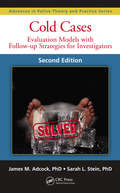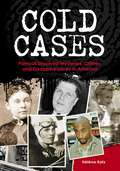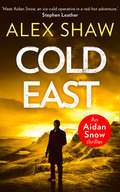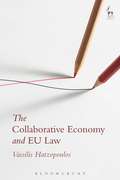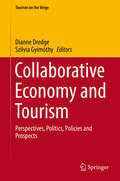- Table View
- List View
Cold Case Research Resources for Unidentified, Missing, and Cold Homicide Cases
by Silvia PettemCases in which all investigative leads appear to be exhausted are frustrating for both investigators and victims families. Cold cases can range from those only a few months old to others that go back for decades. Presenting profiles and actual case histories, Cold Case Research: Resources for Unidentified, Missing and Cold Homicide Cases illustrat
Cold Case Reviews: DNA, Detective Work and Unsolved Major Crimes (Clarendon Studies in Criminology)
by Cheryl AllsopThis book provides the first ethnographic account of a UK major crime review team, providing a comprehensive, conceptual account of cold case reviews not currently available from an academic criminological perspective. . Cold case reviews are a relatively new and innovative form of policing yet, to date, there has been little empirical research into their conduct in the UK. Addressing this empirical void by shining a light on the practicalities and realities of cold case investigations, the author spent eight months with a major crime review team tasked with conducting 28-day reviews of 'live' unsolved murder and stranger rapes and detecting long term unsolved major crimes. The resulting work contains a unique focus on forensic science and the role of the National DNA Database (NDNAD) in cold case reviews, adding to the current debates about the police use of forensic science, as well as consideration of the growing public concern about historic sexual offences and the criminal justice responses to them, with an exploration of the debates around the implications of investigating these crimes many years later. Presenting the key findings in relation to the opportunities and challenges to successful cold case reviews, the role of forensic science and other forms of expertise in cold case reviews, and the political and moral considerations being made in this regard, the resulting work will be of interest to practitioners tasked with investigating long term unsolved crimes and students and researchers interested in policing and investigations.
Cold Case Reviews: DNA, Detective Work and Unsolved Major Crimes (Clarendon Studies in Criminology)
by Cheryl AllsopThis book provides the first ethnographic account of a UK major crime review team, providing a comprehensive, conceptual account of cold case reviews not currently available from an academic criminological perspective. . Cold case reviews are a relatively new and innovative form of policing yet, to date, there has been little empirical research into their conduct in the UK. Addressing this empirical void by shining a light on the practicalities and realities of cold case investigations, the author spent eight months with a major crime review team tasked with conducting 28-day reviews of 'live' unsolved murder and stranger rapes and detecting long term unsolved major crimes. The resulting work contains a unique focus on forensic science and the role of the National DNA Database (NDNAD) in cold case reviews, adding to the current debates about the police use of forensic science, as well as consideration of the growing public concern about historic sexual offences and the criminal justice responses to them, with an exploration of the debates around the implications of investigating these crimes many years later. Presenting the key findings in relation to the opportunities and challenges to successful cold case reviews, the role of forensic science and other forms of expertise in cold case reviews, and the political and moral considerations being made in this regard, the resulting work will be of interest to practitioners tasked with investigating long term unsolved crimes and students and researchers interested in policing and investigations.
Cold Cases: Evaluation Models with Follow-up Strategies for Investigators, Second Edition
by James M. Adcock Sarah L. SteinBecause the investigation of cold cases is usually an arduous and time-consuming task, most law enforcement agencies in the United States are not able to dedicate the resources necessary to support the cold case investigation process. However, when those cases are fully pursued and prosecuted, they often result in convictions and lengthy prison ter
Cold Cases: Famous Unsolved Mysteries, Crimes, and Disappearances in America
by Hélèna KatzThis book explicitly chronicles 40 cases of unsolved murders and disappearances over a period of more than 160 years, tracing the evolution of criminal investigation and forensic techniques.Murders and other violent crimes often leave an indelible mark on society. The 18th-century murder of "Beautiful Cigar Girl" Mary Rogers helped the then newly emerging tabloid papers become a fixture in the United States. The Federal Aviation Administration was spurred into requiring electronic screening of passengers and carry-on luggage by a series of highly-publicized hijackings. Abductions of youth gave birth to Amber Alerts and advertising missing children on milk cartons. And popular TV shows like Law and Order, CSI, and Cold Case document our fascination with police investigations, heinous criminals, and the complicated aftermath of their actions. This book examines 40 well-known cases of unsolved murders and suspected abductions over a period of over 160 years. Cases are organized chronologically to give readers insight into the evolution of criminal investigation techniques and forensics in the last century and a half. Later chapters detail how modern forensics were used in attempts to solve old cold cases or helped generate new leads.
Cold Cases: Famous Unsolved Mysteries, Crimes, and Disappearances in America
by Hélèna KatzThis book explicitly chronicles 40 cases of unsolved murders and disappearances over a period of more than 160 years, tracing the evolution of criminal investigation and forensic techniques.Murders and other violent crimes often leave an indelible mark on society. The 18th-century murder of "Beautiful Cigar Girl" Mary Rogers helped the then newly emerging tabloid papers become a fixture in the United States. The Federal Aviation Administration was spurred into requiring electronic screening of passengers and carry-on luggage by a series of highly-publicized hijackings. Abductions of youth gave birth to Amber Alerts and advertising missing children on milk cartons. And popular TV shows like Law and Order, CSI, and Cold Case document our fascination with police investigations, heinous criminals, and the complicated aftermath of their actions. This book examines 40 well-known cases of unsolved murders and suspected abductions over a period of over 160 years. Cases are organized chronologically to give readers insight into the evolution of criminal investigation techniques and forensics in the last century and a half. Later chapters detail how modern forensics were used in attempts to solve old cold cases or helped generate new leads.
Cold East (An Aidan Snow SAS Thriller #3)
by Alex ShawThe clock is ticking. Will Aidan Snow be able to save the world…again?
Cold Hit (Alexandra Cooper #3)
by Linda FairsteinOn a steamy August evening, after an exhausting day in court, Assistant DA Alexandra Cooper is called to a crime scene. Alongside her colleagues, NYPD detectives Mike Chapman and Mercer Wallace, she views the body of a young woman pulled from the water with her hands and feet obscenely tied to a ladder. But who is she? Her elegant clothes and manicured nails suggest affluent connections, but just how well-connected she is surprises even Alex.From luxurious Fifth Avenue apartments to the avant garde galleries of Chelsea, Alex, Mike and Mercer hunt for a killer in a world where priceless art meets big money in a lethal mix.
Cold River: A Thrilling Romantic Suspense (A Black Falls Novel #2)
by Carla NeggersHannah Shay has finally shown the town of Black Falls what she's worth.
Cold Steel: Lakshmi Mittal and the Multi-Billion-Dollar Battle for a Global Empire
by Tim Bouquet Byron OuseyWhen the world's two largest steel producers went head to head in a bitter struggle for market domination, an epic corporate battle ensued that sent shockwaves through the political corridors of Europe, overheated the world's financial markets and transformed the steel industry. Billions of dollars were at stake.At the heart of the battle were two men: Guy Dollé, Chairman and CEO of Luxembourg-based Arcelor, the world's largest steel producer by turnover and Lakshmi Mittal, a self-made Indian industrialist and the richest man in Great Britain. Only one could prevail . . .
The Cold War, the Space Race, and the Law of Outer Space: Space for Peace (Routledge Studies in Modern History)
by Albert K. LaiThe Cold War, the Space Race, and the Law of Outer Space: Space for Peace tells the story of one of the United Nations’ most enduring and least known achievements: the adoption of five multilateral treaties that compose the international law of outer space. The story begins in 1957 during the International Geophysical Year, the largest ever cooperative scientific endeavor that resulted in the launch of Sputnik. Although satellites were first launched under the auspices of peaceful scientific cooperation, the potentially world-ending implications of satellites and the rockets that carried them was obvious to all. By the 1960s, the world faced the prospect of nuclear testing in outer space, the placement of weapons of mass destruction in orbit, and the militarization of the moon. This book tells the story of how the United Nations tried to seize the promise of peace through scientific cooperation and to ward off the potential for war in the Space Age through the adoption of the Outer Space Treaty, the Rescue and Return Agreement, the Liability Convention, the Registration Convention, and the Moon Agreement. Interdisciplinary in approach, the book will be of interest to scholars in law, history and other fields who are interested in the Cold War, the Space Race, and outer space law.
The Cold War, the Space Race, and the Law of Outer Space: Space for Peace (Routledge Studies in Modern History)
by Albert K. LaiThe Cold War, the Space Race, and the Law of Outer Space: Space for Peace tells the story of one of the United Nations’ most enduring and least known achievements: the adoption of five multilateral treaties that compose the international law of outer space. The story begins in 1957 during the International Geophysical Year, the largest ever cooperative scientific endeavor that resulted in the launch of Sputnik. Although satellites were first launched under the auspices of peaceful scientific cooperation, the potentially world-ending implications of satellites and the rockets that carried them was obvious to all. By the 1960s, the world faced the prospect of nuclear testing in outer space, the placement of weapons of mass destruction in orbit, and the militarization of the moon. This book tells the story of how the United Nations tried to seize the promise of peace through scientific cooperation and to ward off the potential for war in the Space Age through the adoption of the Outer Space Treaty, the Rescue and Return Agreement, the Liability Convention, the Registration Convention, and the Moon Agreement. Interdisciplinary in approach, the book will be of interest to scholars in law, history and other fields who are interested in the Cold War, the Space Race, and outer space law.
Cold Waters: Tangible and Symbolic Seascapes of the North (Springer Polar Sciences)
by Markku Lehtimäki Arja Rosenholm Elena Trubina Nina TynkkynenThis book addresses the Arctic and the northern regions by exploring cold waters and northern seascapes. It focuses on cultural discourses and artistic representations concerning the human experience and imagination of how the Arctic Ocean has been explored and used. It aims to assess what is specific to the northern waters vis-à-vis other sea and water areas in the world. The contextual background is provided by the fundamental shift from terra-based thinking towards aqua-based thinking, including the histories of the northern waters and the innovative ocean studies of the last decades. This book will be of interest to readers in Arctic studies and Sea and Ocean studies (including those with interests in literature, history, cultural and film studies, anthropology and politics), Environmental History and Cultural studies as well as in Russian studies. The book has been assembled with a view towards upper-level undergraduate and post-graduate students and scholars and will also be appropriate for courses in the fields mentioned above. The book will be of interest to specialists working in and with Arctic environmental issues. There is a broad array of international academic networks, environmental, governance and cultural associations outside academia whose members may also find the book of interest.
Coleridge’s Laws: A Study of Coleridge in Malta (PDF)
by Barry Hough Howard Davis Michael John Kooy Lydia DavisSamuel Taylor Coleridge is best known as a great poet and literary theorist, but for one, quite short, period of his life he held real political power - acting as Public Secretary to the British Civil Commissioner in Malta in 1805. This was a formative experience for Coleridge which he later identified as being one of the most instructive in his entire life. In this volume Barry Hough and Howard Davis show how Coleridge's actions whilst in a position of power differ markedly from the idealism he had advocated before taking office - shedding new light on Coleridge's sense of political and legal morality. Meticulously researched and including newly discovered archival materials, Coleridge's Laws provides detailed analysis of the laws and public notices drafted by Coleridge, together with the first published translations of them. Drawing from a wealth of primary sources Hough and Davis identify the political challenges facing Coleridge and reveal that, in attempting to win over the Maltese public to support Britain's strategic interests, Coleridge was complicit in acts of government which were both inconsistent with the the rule of law and contrary to his professed beliefs. Coleridge's willingness to overlook accepted legal processes and personal misgivings for political expediency is disturbing and, as explained by Michael John Kooy's in his extensive Introduction, necessarily alters our understanding of the author and his writing. Coleridge's Laws contributes in new ways to the current debates about Coleridge's achievements, British colonialism and its engagement with the rule of law, nationhood and the effectiveness of the British administration of Malta. It provides essential reading for anybody interested in Coleridge specifically and the Romantics more generally, for political and legal historians and for students of colonial government.
Collaborating Against Child Abuse (PDF): Exploring the Nordic Barnahus Model
by Susanna Johansson Kari Stefansen Elisiv Bakketeig Anna KaldalThis book is open access under a CC BY 4.0 license.This edited collection explores the background and implementation of the Nordic Barnahus (or 'Children's House') model – recognised as one of the most important reforms related to children who are the victims of crime in the Nordic region. This book discusses both its potential to affect change and the challenges facing it. The model was introduced as a response to a growing recognition of the need for more integrated and child-centred services for children exposed to violence and sexual abuse. In the Barnahus structure, different professions work together to ensure that victimized children receive help and treatment and that their legal rights are met. This original study is organised into four broad themes: child-friendliness, support and treatment; the forensic child investigative interview; children’s rights perspectives; and interagency collaboration and professional autonomy. Each themed section includes in-depth chapters from different Nordic countries, outlining and analysing the practice and outcomes of the collaborative work engaged in by Barnahus from different perspectives. The introductory and concluding chapters offer a comparative lens useful for policy and practice implementation within the Nordic welfare state context and beyond, ensuring this book has global academic and practical appeal.
Collaborating for Climate Resilience (Giving Voice to Values)
by Ann Goodman Nilda MesaSupporters of environmental well-being and climate resilience are awakening and mobilizing – cities, states, business, academia, community-based organizations, and the military. They understand the imminent and long-term risks of climate deterioration and they are creating new structures beyond the top-down government policy efforts of the past. This highly practical book provides a clear insight into these collaborative solutions by real organizations in real time. It demonstrates how people from disparate fields and stakeholders cooperate to address climate issues at ground level and reveals how this can be undertaken effectively. Through case studies of key organizations such as the NYC Sustainability Office, Detroiters Working for Environmental Justice, IBM, and West Point Military Academy, readers will understand each party’s role in a cooperative enterprise and the means by which they support climate resiliency, their institutional goals, and their communities. Of particular value, the book illustrates the co-benefits of multi-party resilience planning: faster approval times; reduced litigation; ability to monetize benefits such as positive health outcomes; the economic benefits of cooperation (for example, capacity building through financing climate planning and resilience across public, private, and other sources of funding); and developing a shared perspective. The book will be of great interest to business managers, policymakers, and community leaders involved in combating climate change, and researchers and students of business, public affairs, policy, environment, climate, and urban studies.
Collaborating for Climate Resilience (Giving Voice to Values)
by Ann Goodman Nilda MesaSupporters of environmental well-being and climate resilience are awakening and mobilizing – cities, states, business, academia, community-based organizations, and the military. They understand the imminent and long-term risks of climate deterioration and they are creating new structures beyond the top-down government policy efforts of the past. This highly practical book provides a clear insight into these collaborative solutions by real organizations in real time. It demonstrates how people from disparate fields and stakeholders cooperate to address climate issues at ground level and reveals how this can be undertaken effectively. Through case studies of key organizations such as the NYC Sustainability Office, Detroiters Working for Environmental Justice, IBM, and West Point Military Academy, readers will understand each party’s role in a cooperative enterprise and the means by which they support climate resiliency, their institutional goals, and their communities. Of particular value, the book illustrates the co-benefits of multi-party resilience planning: faster approval times; reduced litigation; ability to monetize benefits such as positive health outcomes; the economic benefits of cooperation (for example, capacity building through financing climate planning and resilience across public, private, and other sources of funding); and developing a shared perspective. The book will be of great interest to business managers, policymakers, and community leaders involved in combating climate change, and researchers and students of business, public affairs, policy, environment, climate, and urban studies.
Collaborative Construction Procurement and Improved Value
by David MoseyThe guide that explores how procurement and contracts can create an integrated team while improving value, economy, quality and client satisfaction Collaborative Construction Procurement and Improved Value provides an important guide for project managers, lawyers, designers, constructors and operators, showing step by step how proven collaborative models and processes can move from the margins to the mainstream. It covers all stages of the project lifecycle and offers new ways to embed learning from one project to the next. Collaborative Construction Procurement and Improved Value explores how strategic thinking, intelligent team selection, contract integration and the use of digital technology can enhance the value of construction projects and programmes of work. With 50 UK case studies, plus chapters from specialists in 6 other jurisdictions, it describes in detail the legal and procedural route maps for successful collaborative teams. Collaborative Construction Procurement and Improved Value: Examines the ways to create an effective contract that will spell success throughout the procurement process Contains helpful case studies from real-world projects and programmes Explores the benefits of the collaborative construction process and how to overcome common obstacles Bridges the gaps between contract law, collaborative working and project management Includes the first analysis of the NEC4 Alliance Contract, the FAC-1 Framework Alliance Contract and the TAC-1 Term Alliance Contract
Collaborative Construction Procurement and Improved Value
by David MoseyThe guide that explores how procurement and contracts can create an integrated team while improving value, economy, quality and client satisfaction Collaborative Construction Procurement and Improved Value provides an important guide for project managers, lawyers, designers, constructors and operators, showing step by step how proven collaborative models and processes can move from the margins to the mainstream. It covers all stages of the project lifecycle and offers new ways to embed learning from one project to the next. Collaborative Construction Procurement and Improved Value explores how strategic thinking, intelligent team selection, contract integration and the use of digital technology can enhance the value of construction projects and programmes of work. With 50 UK case studies, plus chapters from specialists in 6 other jurisdictions, it describes in detail the legal and procedural route maps for successful collaborative teams. Collaborative Construction Procurement and Improved Value: Examines the ways to create an effective contract that will spell success throughout the procurement process Contains helpful case studies from real-world projects and programmes Explores the benefits of the collaborative construction process and how to overcome common obstacles Bridges the gaps between contract law, collaborative working and project management Includes the first analysis of the NEC4 Alliance Contract, the FAC-1 Framework Alliance Contract and the TAC-1 Term Alliance Contract
The Collaborative Economy and EU Law
by Vassilis Hatzopoulos'Disruptive innovation', 'the fourth industrial revolution', 'one of the ten ideas that will change the world'; the collaborative/sharing economy is shaking existing norms. It poses unprecedented challenges in terms of both material policies and governance in almost all aspects of EU law.This book explores the application – or indeed inadequacy – of existing EU rules in the context of the collaborative economy. It analyses the novelties introduced by the collaborative economy and discusses the specific regulatory needs and instruments employed therein, most notably self-regulation. Further, it aims to elucidate the legal status of the parties involved (traders, consumers, prosumers) in these multi-sided economies, and their respective roles in the provision of services, especially with regard to liability issues. Moreover, it delves into a sector-specific examination of the relevant EU rules, especially on data protection, competition, consumer protection and labour law, and comments on the uncertainties and lacunae produced therein. It concludes with the acute question of whether fresh EU regulation would be necessary to avoid fragmentation or, on the contrary, if such regulation would create unnecessary burdens and stifle innovation.Taking a broad perspective and pragmatic view, the book provides a comprehensive overview of the collaborative economy in the context of the EU legal landscape.
The Collaborative Economy and EU Law
by Vassilis Hatzopoulos'Disruptive innovation', 'the fourth industrial revolution', 'one of the ten ideas that will change the world'; the collaborative/sharing economy is shaking existing norms. It poses unprecedented challenges in terms of both material policies and governance in almost all aspects of EU law.This book explores the application – or indeed inadequacy – of existing EU rules in the context of the collaborative economy. It analyses the novelties introduced by the collaborative economy and discusses the specific regulatory needs and instruments employed therein, most notably self-regulation. Further, it aims to elucidate the legal status of the parties involved (traders, consumers, prosumers) in these multi-sided economies, and their respective roles in the provision of services, especially with regard to liability issues. Moreover, it delves into a sector-specific examination of the relevant EU rules, especially on data protection, competition, consumer protection and labour law, and comments on the uncertainties and lacunae produced therein. It concludes with the acute question of whether fresh EU regulation would be necessary to avoid fragmentation or, on the contrary, if such regulation would create unnecessary burdens and stifle innovation.Taking a broad perspective and pragmatic view, the book provides a comprehensive overview of the collaborative economy in the context of the EU legal landscape.
Collaborative Economy and Tourism: Perspectives, Politics, Policies and Prospects (Tourism on the Verge)
by Dianne Dredge Szilvia GyimóthyThis book employs an interdisciplinary, cross-sectoral lens to explore the collaborative dynamics that are currently disrupting, re-creating and transforming the production and consumption of tourism. House swapping, ridesharing, voluntourism, couchsurfing, dinner hosting, social enterprise and similar phenomena are among these collective innovations in tourism that are shaking the very bedrock of an industrial system that has been traditionally sustained along commercial value chains. To date there has been very little investigation of these trends, which have been inspired by, amongst other things, de-industrialization processes and post-capitalist forms of production and consumption, postmaterialism, the rise of the third sector and collaborative governance. Addressing that gap, this book explores the character, depth and breadth of these disruptions, the creative opportunities for tourism that are emerging from them, and how governments are responding to these new challenges. In doing so, the book provides both theoretical and practical insights into the future of tourism in a world that is, paradoxically, becoming both increasingly collaborative and individualized.
Collaborative Environmental Governance Frameworks: A Practical Guide
by Timothy GiesekeThis book takes a practical approach to understanding and describing collaborative governance for resolving environmental problems. It introduces a new collaborative governance assessment model and recognizes that collaborations are a natural result of organizations converging around complex issues. Rather than identifying actors by their type of organization, the actors are identified by the type of role they play. This approach is aligned with how individuals and organizations interact in practice, and their dependance on collaborations to solve emerging environmental problems. The book discusses real cases with governance issues and creates new frameworks for collaborations. Features: Addresses communities at all levels and scales that are gravitating toward collaborations to solve their environmental issues. Prepares and enables individuals to participate in collaborative governance and design collaborative governance frameworks. Introduces the first simplified and standardized model to assess governance using governance actors and styles. Explains governance in simple terms and builds governance frameworks from the individual’s perspective; the smallest, viable unit of governance in a collaboration. Describes "tools of convergence" for collaborative leaders to organize and align activities to create shared-governance outcomes and outputs.
Collaborative Environmental Governance Frameworks: A Practical Guide
by Timothy GiesekeThis book takes a practical approach to understanding and describing collaborative governance for resolving environmental problems. It introduces a new collaborative governance assessment model and recognizes that collaborations are a natural result of organizations converging around complex issues. Rather than identifying actors by their type of organization, the actors are identified by the type of role they play. This approach is aligned with how individuals and organizations interact in practice, and their dependance on collaborations to solve emerging environmental problems. The book discusses real cases with governance issues and creates new frameworks for collaborations. Features: Addresses communities at all levels and scales that are gravitating toward collaborations to solve their environmental issues. Prepares and enables individuals to participate in collaborative governance and design collaborative governance frameworks. Introduces the first simplified and standardized model to assess governance using governance actors and styles. Explains governance in simple terms and builds governance frameworks from the individual’s perspective; the smallest, viable unit of governance in a collaboration. Describes "tools of convergence" for collaborative leaders to organize and align activities to create shared-governance outcomes and outputs.
Collaborative Environmental Management: What Roles for Government-1
by Tomas M. Koontz Toddi A. Steelman JoAnn Carmin Katrina Smith Korfmacher Cassandra Moseley Craig W. ThomasCollaboration has become a popular approach to environmental policy, planning, and management. At the urging of citizens, nongovernmental organizations, and industry, government officials at all levels have experimented with collaboration. Yet questions remain about the roles that governments play in collaboration--whether they are constructive and support collaboration, or introduce barriers. This thoughtful book analyzes a series of cases to understand how collaborative processes work and whether government can be an equal partner even as government agencies often formally control decision making and are held accountable for the outcomes. Looking at examples where government has led, encouraged, or followed in collaboration, the authors assess how governmental actors and institutions affected the way issues were defined, the resources available for collaboration, and the organizational processes and structures that were established. Cases include collaborative efforts to manage watersheds, rivers, estuaries, farmland, endangered species habitats, and forests. The authors develop a new theoretical framework and demonstrate that government left a heavy imprint in each of the efforts. The work concludes by discussing the choices and challenges faced by governmental institutions and actors as they try to realize the potential of collaborative environmental management.


